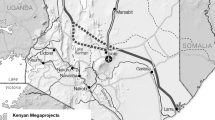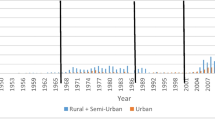Abstract
Social capital, measured as the level of trustamong people, may be regarded as a newproduction factor alongside the traditionalones of human and physical capital. Withappropriate levels of social capital,monitoring and transaction costs can be savedand thus economic growth stimulated. Vialinking social capital to rural development andcomparing the cases of agricultural cooperativemovements in Denmark and Poland, this paperidentifies possible roots of building socialcapital and suggests that social capital wasbuilt through a lengthy process in bothcountries during the 19th century. However,the comparison of the present level of socialcapital indicates that the level of socialcapital is significantly higher in Denmark thanin Poland. The paper concludes that the reasonfor this difference is the fact that theoriginal accumulation of social capital inPoland was destroyed by the communist regime.
Similar content being viewed by others
References
Andelsbladet (1904). Fællesorgan for Danske Andelsforetagender [Journal of the Danish Co-operative Organisations], Vol 5.
Bonanno, A. (1993). “Some reflections of Eastern European agriculture.” Agriculture and Human Values 10(1): 2–10.
Bourdieu, P. (1986). “The forms of capital.” In J. Richardson (ed.), Handbook of Theory and Research for the Sociology of Education. Westport, Connecticut: Greenwood Press.
Chloupkova, J. (2002a). “Polish agriculture: Organisational structure and impacts of transition.” Unit of Economics Working Papers 2002/3. Copenhagen, Denmark: The Royal Veterinary and Agricultural University.
Chloupkova, J. (2002b). “European cooperative movement: Background and common denominators.” Unit of Economics Working Papers 2004/4. Copenhagen, Denmark: The Royal Veterinary and Agricultural University.
Chloupkova, J. and C. Bjørnskov (2002a). “Counting in social capital when easing agricultural credit constraints.” Journal of Microfinance 4(1): 17–36.
Chloupkova, J. and C. Bjørnskov (2002b). “Could social capital help Czech agriculture?” Zemedelska Ekonomika [Agricultural Economics] 48(6): 245–249.
Christensen, J. (1983). “Rural Denmark 1750-1980. The central co-operative committee of Denmark” (edited by Claus Bjørn), Copenhagen, Denmark.
Coleman, J. S. (1988). “Social capital in the creation of human capital.” American Journal of Sociology 94: 95–120.
European Commission (1998). “Agricultural situation and prospects in the Central and Eastern countries: Summary report.” Brussels: Directorate General for Agriculture.
FAO (1994). Reorienting the Cooperative Structure in Selected Eastern European Countries: Summary of Case-studies. Central and Eastern Europe - Agriculture in Transition 1, Food and Agriculture Organization of the United Nations.
Fink, T. (1999). Båndene bandt. [Binding Ties.] Aabenraa, Denmark: IFG Press.
Fukuyama, F. (1995). Trust. The Social Virtues and the Creation of Prosperity. London: Hamish Hamilton.
Haagard, H. R. (1911). Rural Denmark and Its Lessons. London: Longmans Green and Co.
Hjøllund, L., M. Paldam and G. T. Svendsen (2001). “Social capital in Russia and Denmark: A comparative study.” Aarhus School of Business, Working Paper 01-13.
Hunek, T. (1994). Reorienting the Cooperative Structure in Selected Eastern European Countries: Case-Study on Poland. Central and Eastern Europe - Agriculture in Transition 5. Food and Agriculture Organization of the United Nations.
Inglot, S. (1966). Zarys historii polskiego ruchu spoldzielczego. [An outline of the history of Polish cooperatives.] Warsaw, Poland.
International Co-operative Alliance (ICA) (1993). Poland: Cooperatives in Eastern and Central Europe. ICA Studies and Reports. Geneva: International Cooperative Alliance.
International Co-operative Alliance (ICA) (1999). Web page accessed at www.coop.org/ica.
Kaser, M. C. and E. A. Radice (1985). The Economic History of Eastern Europe 1919-1975. Oxford: Clarendon Press.
Landau, Z. and J. Tomaszewski (1985). The Polish Economy in the Twentieth Century. London: Croom Helm.
Lerski, G. J. (1996). Historical Dictionary of Poland 966-1945. Westport, Connecticut: Greenwood Press.
Maliszewski, A. (1995). “The fall of the co-operative movement in Poland: Causes and consequences.” ICA Review 88(1).
Mlcoch, L. (2000). “Od institucionalizace neodpovednosti” [From the institutionalism of unaccountability to the institutionalism of accountability], presented at the conference “Institucionalizace /ne/odpovednosti: globalni svet, evropska integrace and ceske zajmy” [Institutionalism of /un/accountability: global world, European integration and Czech interests], Prague, Czech Republic, 30 November -2 December.
Nelson, H. D. (1983). Poland - a Country Study. Foreign Area Studies, Washington, DC: The American University.
OECD (1995). Poland: Review of Agricultural Policies. Paris, France: Centre for Co-operation with the Economies in Transition, Organisation for Economic Co-operation and Development.
Paldam, M. (2000). “Social capital: One or many? Definition and measurement.” Journal of Economic Surveys 14(5): 629–653 [special issue on Political Economy].
Paldam, M. and G. T.p Svendsen (2002). “Missing social capital and the transition in Eastern Europe.” Journal for Institutional Innovation, Development and Transition 5: 21–34.
Paldam, M. and G. T. Svendsen (2000). “An essay on social capital: Looking for the fire behind the smoke.” European Journal of Political Economy 16, 339–366.
Portes, A. (1998). “Social capital: Its origins and applications in modern sociology.” Annual Review of Sociology 24: 1–24.
Portes, A. and J. Sensenbrenner (1993). “Embeddedness and immigration: Notes on the social determinants of economic action.” American Journal of Sociology 98(6): 1320–1350.
Putnam, R. D. (1993). Making Democracy Work: Civic Traditions in Modern Italy. Princeton, New Jersey: Princeton University Press.
Putnam, R. D. (1995). “Bowling alone: America's declining social capital.” Journal of Democracy 6: 1.
Putnam, R. D. (1996). “The strange disappearance of civic America.” The American Prospect 24 (Winter): 34–48.
Rose, R. (2000). “Getting things done in an anti-modern society: Social capital networks in Russia.” In P. Dasgupta and I. Serageldin (eds.), Social Capital, a Multifaceted Perspective. Washington, DC: The World Bank.
SAEPR/FAPA (2000). Stereotypes in the European Union Concerning Polish agriculture. Warsaw, Poland: Foundation of Assistance Programmes for Agriculture, Agricultural Policy Analysis Unit.
Sonne, C. (1867). Om arbejderforeninger. Til oplysning og veiledning. [About Labour Organisations.] Copenhagen, Denmark: Louis Kleins Bogtrykkeri.
Svendsen, G. T. (2003). Political Economy of the European Union: Institutions, Policy and Economic Growth. Cheltenham, UK: Edward Elgar.
Svendsen, G. L. H. (2000). “Historien anskuet som et kapitalmarked. Selvorganiseringen i de danske landdistrikter 1800-1900.” Fortid og Nutid 1: 23–51.
Svendsen, G. L. H. and G. T. Svendsen (2000). “Measuring social capital: The Danish co-operative dairy movement.” Sociologia Ruralis 40(1): 72–86.
Svendsen, G. L. H. and G. T. Svendsen (2001). “Alleviating poverty: Entrepreneurship and social capital in rural Denmark 1800-1900.” Belgeo 1(3): 231–246.
The World Bank (1990). An Agricultural Strategy for Poland. Report of the Polish, European Community, World Bank Task Force. Washington, DC: The International Bank for Reconstruction and Development/The World Bank.
Thugutt, S. (1937). Spoldzielczosc: zarys ideologii. [Cooperatives, an Outline of Ideology.] Warsaw, Poland.
Wacquant, L. J. D. (1998). “Negative social capital: State breakdown and social destitution in America's urban core.” Netherlands Journal of Housing and the Built Environment 13(1): 25–40.
Author information
Authors and Affiliations
Corresponding author
Rights and permissions
About this article
Cite this article
Chloupkova, J., Svendsen, G.L.H. & Svendsen, G.T. Building and destroying social capital: The case of cooperative movements in Denmark and Poland. Agriculture and Human Values 20, 241–252 (2003). https://doi.org/10.1023/A:1026141807305
Issue Date:
DOI: https://doi.org/10.1023/A:1026141807305




